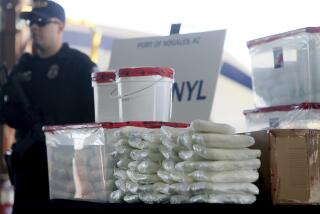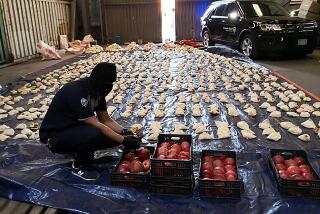Refugees to Resort to Growing Opium, Officials Fear : Afghan Accord May Boost Heroin Trade
- Share via
PESHAWAR, Pakistan — The withdrawal of Soviet troops from war-torn Afghanistan is likely to produce an explosion in the production of heroin earmarked for the United States, according to narcotics experts, diplomats and government officials in Pakistan.
The border region of Pakistan and Afghanistan, which together with Iran forms what is known as the Golden Crescent, already supplies half of the heroin consumed in the United States. Officials here say that after the Soviets complete the withdrawal of their estimated 115,000 troops at the end of this year or early next, the U.S. market may be glutted with heroin.
“I see a horror story coming out of Afghanistan after the Soviet pullout,” said one official who has been watching the Southwest Asian heroin pipeline since it was opened in 1980.
The concern focuses on the 3 million Afghan refugees who have been living in camps along the border in Pakistan since the Soviet troops moved into Afghanistan in late 1979.
Temptation for Refugees
“As these refugees go back, they’ll be desperate,” the official said. “They will have no capital to start businesses. Their country has been destroyed by war, and there’s going to be a great temptation to make money fast. Unfortunately, that means opium and heroin.
“We already have reports of one group of refugees going back to a village in Nangarhar province (in eastern Afghanistan), and . . . their current crop is 60% wheat, 40% opium.”
Officials of the U.S. Drug Enforcement Administration (DEA) have expressed deep concern about increased heroin production and trafficking in Pakistan, which inherited much of the drug trade from its western neighbor after the Soviet intervention there and the revolution in Iran severed heroin land routes to the west.
When the heroin boom began here, the government of Pakistan’s President Zia ul-Haq responded with an aggressive program of enforcement and eradication of the opium poppy. It was regarded as one of the world’s most successful such actions. Production declined in the border area around Peshawar, from an estimated 800 tons in 1979 to only about 40 tons in 1985, according to DEA estimates.
Opium Output Jumped in 1986
Then suddenly Pakistan’s production of opium, from which heroin is refined, “increased significantly in 1986, to about 140 to 160 metric tons,” according to testimony given last year by DEA Administrator John C. Lawn before the House Foreign Affairs Committee.
Lawn noted that scores of heroin refineries were springing up again in Pakistan’s semi-autonomous tribal areas near the border, and he attributed this to “improved weather conditions, resistance by growers and traffickers and weak enforcement.”
For the past two years, visiting State Department officials, international narcotics enforcement agencies and the U.S. ambassador in Islamabad have strongly urged Zia to renew his anti-heroin crackdown. They said policy had become lenient in 1985, when Pakistan elected its first civilian government since Zia overthrew former Prime Minister Zulfikar Ali Bhutto in a 1977 coup.
Adding to the pressure, the House Foreign Affairs Committee warned Pakistan last month to get tough on narcotics control or risk having U.S. aid reduced.
Zia Shook Up Officials
Zia apparently agreed that Pakistan was not doing enough. He dismissed the National Assembly, the Cabinet and all four provincial legislatures on May 29. He charged that through bribery, corruption and the desire to build personal power bases, the elected officials were leading the nation into “step-by-step suicide.”
A few days later, at a meeting with most of the ambassadors stationed in Islamabad, Zia said he was particularly angry that official corruption had led to lax enforcement of the narcotics laws.
“He acknowledged that the reason opium production has increased so much is because the government wasn’t willing to take the hard decision of going in and destroying the poppy,” said a diplomat who was present.
Zia has reason for concern. In 1980, there were no known heroin addicts in Pakistan. Today there are reported to be more than 650,000, all as a result of Pakistan’s role in producing and transporting narcotics.
A survey by the Pakistan Narcotics Control Board disclosed recently that one out of every nine young men in Pakistan’s largest city, Karachi, is addicted to heroin. The drug is so cheap here that an addict can satisfy his daily need with the equivalent of less than $1.
There are 24 heroin treatment clinics scattered across the country, and all have long waiting lists. Most general hospitals are making room for more. But according to DEA officials, the rehabilitation program here has been largely ineffective.
The Reagan Administration, which has poured more than $50 million into Pakistan’s anti-heroin programs, is concerned about the impact on democracy of Zia’s dismissal of so many government officials. But it is also heartened by its expected impact on drug production and trafficking.
“At least there’s no question that we’ll now get tougher narcotics enforcement,” one official said.
Zia has already appointed a tough retired general as acting chief minister of the North-West Frontier province on the Afghan border, where the principal growing areas and refineries are situated.
This official, Fazle Haq, is rumored to have strong personal ties to the heroin barons in the region, but when he served as governor there, before 1985, he directed the most successful drug crackdown the frontier had ever seen. It was during his tenure that Pakistani poppy production was reduced sharply.
Despite Zia’s tough new attitude, U.S. officials are worried about what will happen next year when millions of Afghan refugees are expected to begin streaming back to their villages. Afghanistan, a tribal-based, impoverished nation of widely scattered villages, has always been a major heroin producer. Accurate figures have been hard to come by since the Soviet intervention, but the last DEA estimate, for 1985, put Afghanistan’s annual opium production at 300 to 400 tons. Most of it is believed to have found its way to heroin refineries across the border.
According to Pakistani opposition leaders, a $2-billion covert CIA operation that provided arms for the Afghan resistance also fueled the drug trade. They say that by opening weapons supply routes into Afghanistan, Zia and the CIA have also opened routes for drugs coming out.
Zia and U.S. officials insist that the Afghan resistance fighters, who are fervently Islamic, are not major drug dealers, that many of the commanders forbid drug use as a violation of Islamic law and that they use their troops to fight drugs.
“There has never been any real proof of moujahedeen trafficking in drugs,” a diplomatic observer in Islamabad said. “And while we are very concerned about a great increase in opium growing and heroin processing after the (Soviet) pullout, the moujahedeen themselves may be our saving grace. The basic problem in this region is that as long as there’s a lack of government control, you’ll have a lot of opium. And, yes, that is a very serious concern.”
More to Read
Sign up for Essential California
The most important California stories and recommendations in your inbox every morning.
You may occasionally receive promotional content from the Los Angeles Times.













